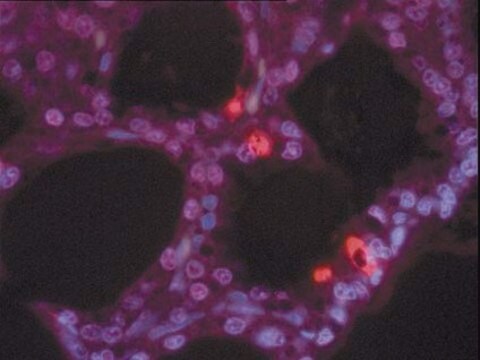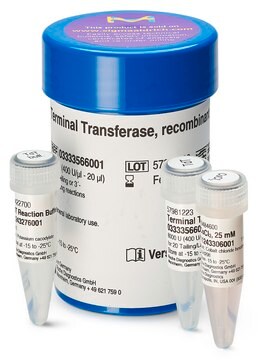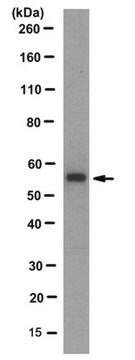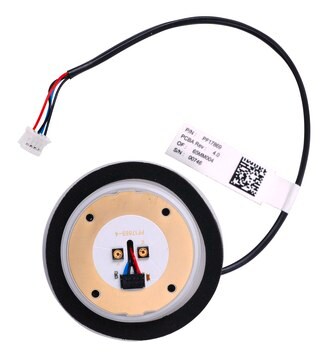About This Item
Kod UNSPSC:
12352202
NACRES:
NA.71
Polecane produkty
Formularz
liquid
Poziom jakości
nie zawiera
preservative
producent / nazwa handlowa
Calbiochem®
warunki przechowywania
OK to freeze
avoid repeated freeze/thaw cycles
Warunki transportu
wet ice
temp. przechowywania
−20°C
Opis ogólny
Calbiochem® Terminalna transferaza deoksynukleotydylowa (TdT) jest polimerazą DNA izolowaną z grasicy cielęcej. TdT katalizuje dodawanie deoksynukleotydów do 3′-hydroksylowych końców podwójnych lub jednoniciowych cząsteczek DNA w sposób niezależny od matrycy. Chociaż TdT preferencyjnie dodaje deoksynukleotydy do rozszerzeń 3′, można również osiągnąć ogonowanie na zwisach 5′ lub tępo zakończonych podwójnych niciach DNA. TdT może być stosowana do znakowania fragmentów DNA i wektorów z ogonami homopolimerowymi i/lub ze zmodyfikowanymi deoksynukleotydami, takimi jak biotyna-dNTP, 32P-dNTP, kordycepina-dNTP lub ddNTP.
Natywna TdT z grasicy cielęcej. Tdt jest polimerazą DNA, która katalizuje dodawanie deoksynukleotydów do końca hydroksylowego 3′ obu podwójnych pojedynczych nici DNA w sposób niezależny od szablonu.
Zastosowanie
Znakowanie DNA
Ostrzeżenie
Toksyczność: Standardowa obsługa (A)
Definicja jednostki
Jedna jednostka to ilość enzymu wymagana do przeniesienia 1 nmol dAMP z dATP na koniec 3ʹ-OH d(A)50 w ciągu 60 minut w temperaturze 37°C.
Postać fizyczna
775 jednostek w 50 mM buforze fosforanu potasu, 1 mM B-merkaptoetanolu, 50% glicerolu, pH 7,2.
Rekonstytucja
Po wstępnym rozmrożeniu, podzielić i zamrozić (-20°C).
Inne uwagi
Chang, L.M.S. i F.J. Bollum. 1986. Crit. Rev. Biochem.21, 27.
Deng, G. i R. Wu. 1983. Methods Enzymol. 100, 96.
Michelson, A.M. i S.H. Orkin. 1982. J. Biol. Chem.257, 14773.
Roychoudhury, R. and R. Wu. 1980. Methods Enzymol.65, 43.
Nelson, T. and D. Brutlag. 1979. Methods Enzymol. 68, 41.
Roychoudhury, R., et al. 1976. Nucleic Acids Res.3, 101.
Bollum, F.J. 1974. In The Enzymes, 3rd edition (ed. P.D. Boyer), Vol. 10, 145. Academic Press, New York.
Deng, G. i R. Wu. 1983. Methods Enzymol. 100, 96.
Michelson, A.M. i S.H. Orkin. 1982. J. Biol. Chem.257, 14773.
Roychoudhury, R. and R. Wu. 1980. Methods Enzymol.65, 43.
Nelson, T. and D. Brutlag. 1979. Methods Enzymol. 68, 41.
Roychoudhury, R., et al. 1976. Nucleic Acids Res.3, 101.
Bollum, F.J. 1974. In The Enzymes, 3rd edition (ed. P.D. Boyer), Vol. 10, 145. Academic Press, New York.
Informacje prawne
CALBIOCHEM is a registered trademark of Merck KGaA, Darmstadt, Germany
Ta strona może zawierać tekst przetłumaczony maszynowo.
Kod klasy składowania
10 - Combustible liquids
Klasa zagrożenia wodnego (WGK)
WGK 2
Certyfikaty analizy (CoA)
Poszukaj Certyfikaty analizy (CoA), wpisując numer partii/serii produktów. Numery serii i partii można znaleźć na etykiecie produktu po słowach „seria” lub „partia”.
Masz już ten produkt?
Dokumenty związane z niedawno zakupionymi produktami zostały zamieszczone w Bibliotece dokumentów.
Nasz zespół naukowców ma doświadczenie we wszystkich obszarach badań, w tym w naukach przyrodniczych, materiałoznawstwie, syntezie chemicznej, chromatografii, analityce i wielu innych dziedzinach.
Skontaktuj się z zespołem ds. pomocy technicznej







